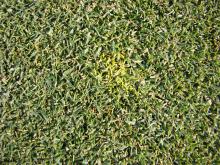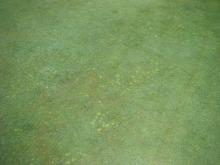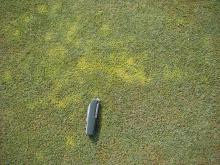Hosts Poa annua and low-mowed bermudagrass (Cynodon spp.) in the PNW as well as creeping bentgrass (Agrostis palustris) in the southeast USA.
Cause Blue-green algae also known as Cyanobacteria including Oscillatoria sp. or Phormidium sp. Drought stress, low fertility, use of organic fertilizers, low mowing and shade seem to encourage disease development. Symptoms are thought to occur when toxins from the cyanobacteria diffuse into the leaves through cut leaf tips.
Symptoms Small spots of yellow turf that start out about 1-inch in diameter but can expand up to 3 or 4 inches. Within the spots the turfgrass does not have signs of abnormal growth. Spots stay in discreet infection centers. A mat of algal growth is consistently observed in the crowns and leaf sheaths or leaves of yellowed plants. Affected turf gradually begins to thin and decline until large patches of turf are mottled and yellow.
Cultural control
- Improve soil drainage.
- Mow higher in periods of stress such as dry or hot weather.
- Provide for more light by pruning shrubs or trees.
Chemical control Regular applications of broad spectrum fungicides such as group M5 have been be effective. Do not use group 11 fungicides as they seem to intensify symptoms.
- Daconil Weather Stik at 2 to 3.6 fl oz/1,000 sq ft or at 5.5 fl oz/1,000 sq ft if algae are well established. Group M5 fungicide. 12-hr reentry.
- Encartis at 3 to 4 fl oz/1,000 sq ft. Do not use with oil-based pesticides. Group 7 + M5 fungicide. Reentry when sprays have dried.
- Mancozeb 80% (Fore, Manzate, or Protect DF) at 6 oz/1,000 sq ft. Group M3 fungicide. 24-hr reentry.
- Previa at 2 to 5.5 fl oz/1,000 sq ft. Group M5 fungicide. 12-hr reentry.
Reference Tredway, L.P., Stowell, L.J., and Gelernter, W.D. 2006. Yellow spot and the potential role of cyanobacteria as turfgrass pathogens. Golf course management. PACE Turfgrass Research Institute, San Diego, pp.83-86.




